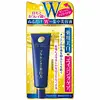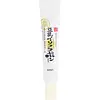What's inside
What's inside
 Key Ingredients
Key Ingredients

 Benefits
Benefits

 Concerns
Concerns

 Ingredients Side-by-side
Ingredients Side-by-side

Placental Extract
Tocopheryl Acetate
AntioxidantCollagen
MoisturisingTripeptide-8
Skin ConditioningCoix Lacryma-Jobi Ma-Yuen Seed Extract
Skin ConditioningDiospyros Kaki Fruit Extract
Skin ConditioningPCA
HumectantAluminum Acetate Solution
AstringentMalic Acid
BufferingOryza Sativa Bran Oil
EmollientGlycosphingolipids
EmollientPhospholipids
Skin ConditioningTocopherol
AntioxidantHydroxyproline
Skin ConditioningGlycerin
HumectantButylene Glycol
Humectant1,5-Pentanediol
SolventPolyglyceryl-2 Oleate
EmulsifyingGlyceryl Stearate
EmollientPolyglyceryl-5 Stearate
EmulsifyingEthylhexyl Palmitate
EmollientBeeswax
Emulsion StabilisingDimethicone
EmollientStearic Acid
CleansingCaprylyl Alcohol
MaskingPolypentaerythrityl C5-10 Acid Esters
Hydrogenated Polybutene
Behenyl Alcohol
EmollientC4-18 Alkyl Methacrylate/Methacryloyloxyethyl Phosphorylcholine Copolymer
HumectantAlcohol Denat.
AntimicrobialPhenoxyethanol
PreservativeSodium Paraben
PreservativeParfum
MaskingPlacental Extract, Tocopheryl Acetate, Collagen, Tripeptide-8, Coix Lacryma-Jobi Ma-Yuen Seed Extract, Diospyros Kaki Fruit Extract, PCA, Aluminum Acetate Solution, Malic Acid, Oryza Sativa Bran Oil, Glycosphingolipids, Phospholipids, Tocopherol, Hydroxyproline, Glycerin, Butylene Glycol, 1,5-Pentanediol, Polyglyceryl-2 Oleate, Glyceryl Stearate, Polyglyceryl-5 Stearate, Ethylhexyl Palmitate, Beeswax, Dimethicone, Stearic Acid, Caprylyl Alcohol, Polypentaerythrityl C5-10 Acid Esters, Hydrogenated Polybutene, Behenyl Alcohol, C4-18 Alkyl Methacrylate/Methacryloyloxyethyl Phosphorylcholine Copolymer, Alcohol Denat., Phenoxyethanol, Sodium Paraben, Parfum
Water
Skin ConditioningGlycerin
HumectantButylene Glycol
HumectantSqualane
EmollientDipentaerythrityl Tetrahydroxystearate/Tetraisostearate
Skin ConditioningBehenyl Alcohol
EmollientPvp
Emulsion StabilisingPentaerythrityl Tetraethylhexanoate
EmollientPEG-150
HumectantDimethicone
EmollientPentylene Glycol
Skin ConditioningBeeswax
Emulsion StabilisingDipentaerythrityl Tri-Polyhydroxystearate
EmollientPEG-60 Glyceryl Isostearate
Macadamia Ternifolia Seed Oil
EmollientGlyceryl Stearate
EmollientTrimethylsiloxysilicate
EmollientRetinol
Skin ConditioningRetinyl Palmitate
Skin ConditioningMilk Ferment
Skin ConditioningSoy Isoflavones
Skin ConditioningGlycine Max Seed Extract
Skin ConditioningCeramide Ng
Skin ConditioningSodium Tocopheryl Phosphate
AntioxidantDipropylene Glycol
HumectantPEG-40 Hydrogenated Castor Oil
EmulsifyingPPG-4-Ceteth-20
EmulsifyingSodium Ascorbate
AntioxidantAlcohol Denat.
AntimicrobialEthylhexylglycerin
Skin ConditioningCarbomer
Emulsion StabilisingXanthan Gum
EmulsifyingZea Mays Oil
EmulsifyingTocopherol
AntioxidantCaprylic/Capric Triglyceride
MaskingPolysorbate 80
EmulsifyingInulin Lauryl Carbamate
Emulsion StabilisingLecithin
EmollientSodium Hydroxide
BufferingPhenoxyethanol
PreservativeMethylparaben
PreservativeWater, Glycerin, Butylene Glycol, Squalane, Dipentaerythrityl Tetrahydroxystearate/Tetraisostearate, Behenyl Alcohol, Pvp, Pentaerythrityl Tetraethylhexanoate, PEG-150, Dimethicone, Pentylene Glycol, Beeswax, Dipentaerythrityl Tri-Polyhydroxystearate, PEG-60 Glyceryl Isostearate, Macadamia Ternifolia Seed Oil, Glyceryl Stearate, Trimethylsiloxysilicate, Retinol, Retinyl Palmitate, Milk Ferment, Soy Isoflavones, Glycine Max Seed Extract, Ceramide Ng, Sodium Tocopheryl Phosphate, Dipropylene Glycol, PEG-40 Hydrogenated Castor Oil, PPG-4-Ceteth-20, Sodium Ascorbate, Alcohol Denat., Ethylhexylglycerin, Carbomer, Xanthan Gum, Zea Mays Oil, Tocopherol, Caprylic/Capric Triglyceride, Polysorbate 80, Inulin Lauryl Carbamate, Lecithin, Sodium Hydroxide, Phenoxyethanol, Methylparaben
 Reviews
Reviews

Alternatives
Ingredients Explained
These ingredients are found in both products.
Ingredients higher up in an ingredient list are typically present in a larger amount.
Alcohol Denat. is an alcohol with a denaturant property. It is created by mixing ethanol with other additives.
This ingredient gets a bad rep because it is irritating and drying - mostly due to its astringent property. Astringents draw out natural oils in tissue, constricting pores and leaving your skin dried out.
However, alcohol denat. is not all that bad.
Due to its low molecular weight, alcohol denat. tends to evaporate quickly. One study on pig skin found half of applied alcohol evaporated in 10 seconds and less than 3% stayed on skin.
This also helps other ingredients become better absorbed upon application.
Studies are conflicted about whether this ingredient causes skin dehydration. One study from 2005 found adding emollients to propanol-based sanitizer decreased skin dryness and irritation. Another study found irritation only occurs if your skin is already damaged.
Small amounts of alcohol are generally tolerated by oily skin or people who live in humid environments.
The rule of thumb is if this alcohol is near the end of an ingredients list, it will probably not affect your skin much.
Also...
This ingredient has antimicrobial and solvent properties.
The antimicrobial property helps preserve products and increase their shelf life. As a solvent, it helps dissolve other ingredients.
Other types of astringent alcohols include:
Learn more about Alcohol Denat.Beeswax is natural wax produced by honey bees and can be synthetically created. It consists mainly of fatty acid esters and long-chain alcohols.
In cosmetics, beeswax is a emollient. Due to its waxy structure, it creates a protective barrier. This barrier prevents water from evaporating off the skin.
This may not be a good ingredient for oily skin. We recommend speaking with a professional if you have concerns.
Beeswax cannot be removed with water, but can be taken off with an oil cleanser.
Beeswax is also antiseptic and contains vitamin A.
Learn more about BeeswaxBehenyl Alcohol is a type of fatty alcohol (these are different from the drying, solvent alcohols).
Fatty Alcohols have hydrating properties and are most often used as an emollient or to thicken a product. They are usually derived from natural fats and oils; behenyl alcohol is derived from the fats of vegetable oils.
Emollients help keep your skin soft and hydrated by creating a film that traps moisture in.
In 2000, Behenyl Alcohol was approved by the US as medicine to reduce the duration of cold sores.
Learn more about Behenyl AlcoholButylene Glycol (or BG) is used within cosmetic products for a few different reasons:
Overall, Butylene Glycol is a safe and well-rounded ingredient that works well with other ingredients.
Though this ingredient works well with most skin types, some people with sensitive skin may experience a reaction such as allergic rashes, closed comedones, or itchiness.
Learn more about Butylene GlycolDimethicone is a type of synthetic silicone created from natural materials such as quartz.
What it does:
Dimethicone comes in different viscosities:
Depending on the viscosity, dimethicone has different properties.
Ingredients lists don't always show which type is used, so we recommend reaching out to the brand if you have questions about the viscosity.
This ingredient is unlikely to cause irritation because it does not get absorbed into skin. However, people with silicone allergies should be careful about using this ingredient.
Note: Dimethicone may contribute to pilling. This is because it is not oil or water soluble, so pilling may occur when layered with products. When mixed with heavy oils in a formula, the outcome is also quite greasy.
Learn more about DimethiconeGlycerin is already naturally found in your skin. It helps moisturize and protect your skin.
A study from 2016 found glycerin to be more effective as a humectant than AHAs and hyaluronic acid.
As a humectant, it helps the skin stay hydrated by pulling moisture to your skin. The low molecular weight of glycerin allows it to pull moisture into the deeper layers of your skin.
Hydrated skin improves your skin barrier; Your skin barrier helps protect against irritants and bacteria.
Glycerin has also been found to have antimicrobial and antiviral properties. Due to these properties, glycerin is often used in wound and burn treatments.
In cosmetics, glycerin is usually derived from plants such as soybean or palm. However, it can also be sourced from animals, such as tallow or animal fat.
This ingredient is organic, colorless, odorless, and non-toxic.
Glycerin is the name for this ingredient in American English. British English uses Glycerol/Glycerine.
Learn more about GlycerinGlyceryl Stearate is a mix of glycerin and stearic acid.
It is used to stabilize the mixing of water and oil ingredients. By preventing these ingredients from separating, it can help elongate shelf life. It can also help thicken the product's texture.
As an emollient, it helps soften skin and supports barrier-replenishing ingredients.
In cosmetics, Glyceryl Stearate is often made from vegetable oils or synthetically produced.
This ingredient may not be fungal-acne safe
Fun fact: The human body also creates Glyceryl Stearate naturally.
Learn more about Glyceryl StearatePhenoxyethanol is a preservative that has germicide, antimicrobial, and aromatic properties. Studies show that phenoxyethanol can prevent microbial growth. By itself, it has a scent that is similar to that of a rose.
It's often used in formulations along with Caprylyl Glycol to preserve the shelf life of products.
Tocopherol (also known as Vitamin E) is a common antioxidant used to help protect the skin from free-radicals and strengthen the skin barrier. It's also fat soluble - this means our skin is great at absorbing it.
Vitamin E also helps keep your natural skin lipids healthy. Your lipid skin barrier naturally consists of lipids, ceramides, and fatty acids. Vitamin E offers extra protection for your skin’s lipid barrier, keeping your skin healthy and nourished.
Another benefit is a bit of UV protection. Vitamin E helps reduce the damage caused by UVB rays. (It should not replace your sunscreen). Combining it with Vitamin C can decrease sunburned cells and hyperpigmentation after UV exposure.
You might have noticed Vitamin E + C often paired together. This is because it is great at stabilizing Vitamin C. Using the two together helps increase the effectiveness of both ingredients.
There are often claims that Vitamin E can reduce/prevent scarring, but these claims haven't been confirmed by scientific research.
Learn more about Tocopherol